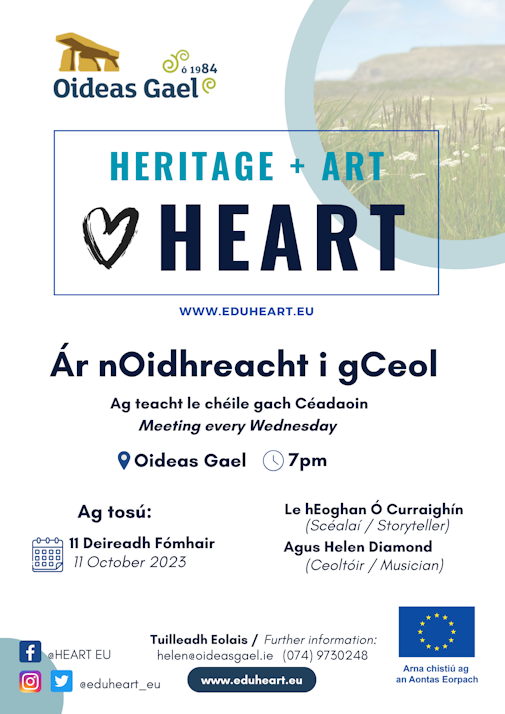Tips for advertising a course
- Produced by
- Oideas Gael
- Author
- Helen Diamond

Video
Oideas Gael Pilot — Week 1
This is a 360-degree video. Click or drag the video to change your viewpoint and observe activity in different parts of the scene. If 360-degree videos are not supported in your browser, you can open the video in the YouTube app.
1. Understand your target audience
When exploring advertising methods, it's important to bear your target audience in mind. Consider factors such as age bracket, gender, location, preferred communication channels, and potential barriers to participation. It is important to use different types of advertising according to the demographic/s you are trying to reach. Traditional media such as newsletters, printed posters and fliers can be combined with digital and social media, and word of mouth.
Tips from Oideas Gael
When advertising the Irish pilot we began by selecting our target group. We knew that it would be relatively easy to reach those who regularly engage with our courses and projects, but for this pilot we wanted to reach a wider audience among the community, filling the gaps in our reach. In order to expand to a broader range of demographics we used a mixture of social and traditional media, including social media platforms, printed posters and fliers, community newsletters, and local radio.
Tips from Kansalaisfoorumi
In addition to other advertising methods, we also contacted various networks of stakeholders directly. Our identified participant groups included art educators, history teachers and people interested in creative writing. We contacted these groups through central organisations, mailing lists and related Facebook groups.
2. Digital platforms
- Social media platforms are useful for promoting courses, and are often free and easy to use. In order to make your posts engaging include images and media as well as all the basic information such as time, place, cost, and any equipment needed.
- When making social media posts remember to tag / invite people or organisations and stakeholders who may share your posts. Each platform will have different systems for this. For example, with Instagram a story can only be shared by someone who is tagged in that story. It is worth spending some time familiarizing yourself with the conventions the apps you are using.
- Consider building an email list of interested individuals and regularly send out newsletters or course updates.
- Ensure your organization's website is user-friendly, kept up-to-date and contains comprehensive information about your courses.
Example – Oideas Gael
At our organisation we have a set of strategies we use to advertise our regular courses. These include our website, mailing list and Facebook and Instagram pages.
Consider searching for related social media groups where you may find people interested in your course, or the heritage topic in general!
3. Traditional advertising methods
- Printed flyers, posters, and brochures can be distributed in community spaces, coffee shops, and local businesses. Ensure the information is clear, concise, and visually appealing. Paper advertising can reach groups who may not be active online, so aim for locations frequented by those you are possibly missing.
- Consider contacting local media outlets such as radio stations and newsletters to secure advertisements or features about your courses.
Example – Oideas Gael
We knew that by using our social media channels, website and mailing list, we would reach many of our regular course attendees. However, we wanted to reach community members who may not be active online. We therefore printed posters and hung them in central locations such as the local shop, post office, cafes and community centre. We entered a notice to be printed in the parish newsletter which is distributed the church, and secured a promotional interview on national radio.
4. Offer an open night or information session
Organize free taster sessions or open houses where prospective participants can experience a sample of what your courses offer. Use these events as opportunities to showcase your organization's values, teaching style, and community impact.
Example – Oideas Gael
It was important for us that community voices be involved in the planning and design of our project. We therefore held an open night / information session where potential participants could come and learn about the project and express their ideas and opinions. This was advertised through the above listed channels, including digital and traditional media. The night opened with a presentation by the art educator, which informed the audience about the general background of the HEART project. An open discussion session was then held during which community members could input their ideas about what form the Oideas Gael pilot should take. The process which began on that night formed the basis for the first meeting, during which the project was further planned and developed.
Sample materials
Posters used to advertise the open night, and pilot group
These posters were printed and hung in strategic locations within the community. They were also used for social media posts on Facebook and Instagram. They were designed using the free version of the Canva app. Information was presented clearly and legibly, in both Irish and English. This decision was made in order to expand our reach as broadly as possible. The questions and answers on the first poster were included in order to encourage people outside of our usual reach.
Included below is the poster for the final performance of the pilot group. In creating the posters we tried to ensure a consistent branding style. It is also important to include the logos of all supporting organisations and funding bodies.



Here is a poster used for the Kansalaisfoorumi pilot:
